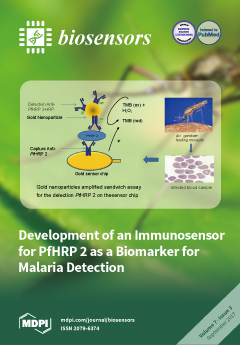Plasmodium falciparum histidine-rich protein 2 (
PfHRP 2) was selected in this work as the biomarker for the detection and diagnosis of malaria. An enzyme-linked immunosorbent assay (ELISA) was first developed to evaluate the immunoreagent’s suitability for the sensor’s development. A gold-based
[...] Read more.
Plasmodium falciparum histidine-rich protein 2 (
PfHRP 2) was selected in this work as the biomarker for the detection and diagnosis of malaria. An enzyme-linked immunosorbent assay (ELISA) was first developed to evaluate the immunoreagent’s suitability for the sensor’s development. A gold-based sensor with an integrated counter and an Ag/AgCl reference electrode was first selected and characterised and then used to develop the immunosensor for
PfHRP 2, which enables a low cost, easy to use, and sensitive biosensor for malaria diagnosis. The sensor was applied to immobilise the anti-
PfHRP 2 monoclonal antibody as the capture receptor. A sandwich ELISA assay format was constructed using horseradish peroxidase (HRP) as the enzyme label, and the electrochemical signal was generated using a 3, 3′, 5, 5′tetramethyl-benzidine dihydrochloride (TMB)/H
2O
2 system. The performance of the assay and the sensor were optimised and characterised, achieving a
PfHRP 2 limit of detection (LOD) of 2.14 ng·mL
−1 in buffer samples and 2.95 ng∙mL
−1 in 100% spiked serum samples. The assay signal was then amplified using gold nanoparticles conjugated detection antibody-enzyme and a detection limit of 36 pg∙mL
−1 was achieved in buffer samples and 40 pg∙mL
−1 in serum samples. This sensor format is ideal for malaria detection and on-site analysis as a point-of-care device (POC) in resource-limited settings where the implementation of malaria diagnostics is essential in control and elimination efforts.
Full article






